PEARLS
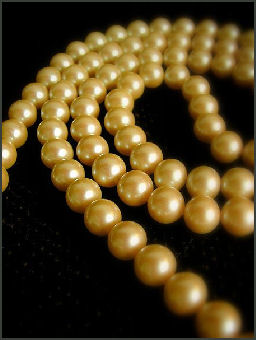
Pearls are produced by oysters as everyone knows. They are composed of 90 percent argonite calcium carbonate, a substance applied to a nucleus of pearl by the same organ (the mantle) of the oyster that creates the shell, and 10 percent conchiolin, a gluelike protein that binds together the calcium carbonate crystals. Fossil pearls are abundant in 60 million-year-old rocks. [Source: Fred Ward, National Geographic, August 1985 ┦; David Doubilet, National Geographic, December 1991; Nigel Sitwell, Smithsonian]
Calcium carbonate is the material from which cement and limestone are made and argon is an inert gas like neon. This nacre is applied in layers about a thousandth of an inch thick. The growth pattern makes cultured and natural pearls feel rough when rubbed on the teeth. One advantage pearls have over gem stones and gold is that didn't require any cutting or smelting. They came straight from the shell ready to go. This was especially important to ancient people didn't the have the technology we have today to cut stone and produce metal.
It is said that pearls form inside shellfish that have foreign object inside them that is an irritant. It is speculated that the objects causes pain and covering it with nacre makes it smoother and less irritating.
Pearls come in a wide variety of colors and shades’silver, cream, old, green, blue and black — and seem to glow from within because light penetrates the surface and reflects off the inner layers. They respond differently to different kinds of light and enhance the color of a woman's skin Many people prefer pearls to diamonds because they believe they compliment a woman’s beauty rather than upstage it. One gem buyer with Van Cleef & Areples told Smithsonian, "In the jewelry business, pearls are considered the most feminine of gems. I don't know a woman who doesn't lie pearls."
See Separate Articles OYSTERS: TYPES, CHARACTERISTICS AND FARMING ioa.factsanddetails.com ; CULTURED PEARLS, JAPAN AND KOKICHI MIKIMOTO factsanddetails.com
Good Websites and Sources: Kari Pearls karipearls.com ; Mikimoto Pearl Museum mikimoto-pearl-museum.co.jp ; Mikimoto Pearl Island karipearls.com ; Japan Pearl Exporters Association japan-pearl.com ; Wikipedia article on the Pearl Wikipedia ; Pearl Basics thepearloutlet.com ; Japanese Akoya Pearl pearl-guide.com ; Yokata Pearls in Kobe yokota-pearl.co.jp ; Kobe Precious Pearl portnet.ne.jp ; Mikimoto Pearl Island Tourism Japan Guide japan-guide.com ; Saikai National Park: (west of Nagasaki) features beautiful islands, splendid bays and beds of cultured pearls. The town of Sasebo is a starting point for boat trips to the islands Website: Government National Park Site National Parks of Japan
Early History of Pearls
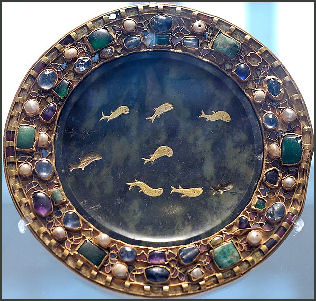
Pearls were among the first precious stones to be worn by mankind. In ancient times pearls were featured in religious ornament and used for medicinal purposes and seen as symbols of purity, chastity and feminine charms.
Pearls were described in a 5,000-year-old Hindu legend about Krishna and a 4,300-year-old Chinese story of daughter the of a king. They are mentioned as symbols of wealth in the Talmud and the Bible and were found at 5500-year-old archeological sights in America and Europe. The ancient Greeks though that pearls were created by lightning struck by the sea. Other ancient peoples believed they were raindrops or dewdrops captured by clams.
The oldest surviving pearl necklace, dated to around 350 B.C., was found at Susa in western Iran, the home of a winter palace of a Persian king. Pearls were also unearthed in 2,500-year-old sites at Mount Albán Mexico as well as in ancient Peru.
Roman women adorned furniture and gowns with pearls and liked to sleep with pearls so "their dreams would be filled with lustrous gems.” Caligula wore slippers covered with pearls and draped a pearl necklace around the neck of his favorite horse Incitatus; Nero decorated his scepter and Constantine his helmet with pearls; and one of reasons why Julius Caesar invaded Britain in 55 B.C. was to get his hand on freshwater pearls from Scotland. The Roman general Vitellus paid for an entire military campaigns by selling one of his mothers pearls.
The Romans thought they were tears of the gods frozen inside of oysters. Cleopatra once bet Marc Anthony she could give the world's most expensive dinner party. To win the bet she crushed one of her pearl earrings and drank it in a goblet of wine. That one earring was said to worth 100,000 pounds of silver.
For more about Pearls in Ancient Rome See JEWELRY IN ANCIENT ROME europe.factsanddetails.com
Pearls in the Persian Gulf
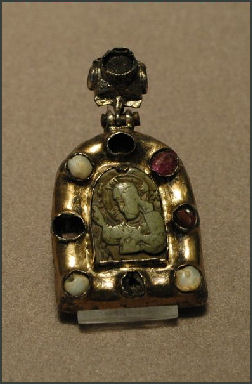
Pearl diving is believed to have been practiced in Bahrain for 4,000 years. The first reference to Bahrain pearling is a an Assyrian inscription from 200 B.C. that described "a parcel of fish eyes from Dilmun." In 100 A.D. the Roman chronicler Pliny described Tylos as being "famous for its vast numbers of pearls." Tylos and Dilmun were ancient names for Bahrain.
For centuries the Persian Gulf was the main gathering place of gem-quality pearls and Bombay was the home of one of the main pearl market. Arab sheiks in the 19th century amassed huge fortunes not from oil but from royalties on pearl gathering boats. In 1838, a British officer reported that Persian Gulf pearling industry was of comprised of 4,300 boats (3,500 of them in Bahrain) and 30,000 sailors, rope attendants and divers.
Around the turn of the century, there were about 900 Bahrain-based vessels engaged in the pearl fishing. In 1932, the ruler Rhaikh Hamad was appalled by the deplorable working conditions endured by pearl divers and he introduced financial reforms to give the industry sounder footing.
Until the early 1930s the pearl collecting trade was dealt two crippling blows: 1) the mass production of cultured pearls in Japan and 2) world-wide depression. Although the pearl trade is a shadow of its former self it counties to endure. Manama Bahrain was still the center of the natural pearl industry in the 1970s. Specialized pearl traders still work in the souks in Manama and Muharaq.
See Separate Article: PEARL DIVING IN THE PERSIAN GULF africame.factsanddetails.com
Pearl Diving
Pearl diving is dangerous, seasonal work. The main pearl diving season is from June to October. The is also a "cold diving season" before and after the five-month diving season and their length varies according to the weather. During the pearling season, pearl divers live in seasonal pearling villages.
In the old days, great fanfare was made when the pearlers left their home villages for the seasonal pearling villages. Many worked from "sambouqs" and "jalibuts", boats specially designed for pearl fishing and worked by 15 divers and 15 haulers who worked in teams. The ship has a single deck and the crew slept cramped together.
The Persian Gulf pearl industry relied on the labor of Indian and Arab divers, who worked under slavelike conditions and often had their lives cut short by their trade.
Pearl Divers

The pearling methods changed little over the centuries. The methods described by chronicler Abu Zayd Hassan in the 10th century were virtually identical to those used in early 20th century. Looped ropes with stone metal anchors wee tied to the boats. The diver used these ropes to descend quickly to the seabed. Their only equipment was a nose clip, finger-protecting-leather guards, a knife to cut open the shells and bag for the pearls.
The divers usually took two or three deep breath and leapt off the boat and descended to the oyster beds with a rope tied around a stone. Underwater they cut open as many shells as possible or placed as many oyster as they could in a basket and then tugged on a rope to be pulled up. When the divers needed air they tugged on the ropes and were pulled. After a few minutes rest they descended again.
On average each divers brought up between 200 and 400 oysters a day. The divers were often harassed by sharks (Marco Polo reported men who were paid to "charm the great fishes to prevent them from injuring the divers") and some reportedly kept diving even after limbs were bitten off.
One pearler told National Geographic in the 1960s, “When I was ready to dive I roped a heavy stone around one foot, slung a rope basket around my neck, and clipped shut my nostrils. I dived, and when felt my breath giving out, I tugged on th rope and my hauler pulled me up. I divided about 40 times a day. Some diver stayed down for four minutes and some only a minute and a half. An experienced diver would plunger 50 feet.”
Later Pearl History
The Koran describes paradise as being filled pearls and emeralds. Potions with ground pearls were consumed by Mogul emperors as an aphrodisiac and by Charles VI of France to treat his lunacy. Pearls were popular among royals because faceting technology for faceting gems was not invented until the mid 17th-century.
Queen Isabella and King Ferdinand told Columbus it was more important to bring back pearls than it was to return with gold, silver and spices. His discovery of large amounts of natural pearls in the "Pearl Coast" near the Orinico River off Venezuela triggered a rush to the area. So many pearling sites were discovered around the Caribbean after Columbus's voyage in 1492 that America was know in Spain for many years as the Land of Pearls.
Pearls were the most treasured gem until the 19th century when they were replaced by diamonds. Before cultured pearls dominated the market, most of the world's natural pearls came from the Persian Gulf. The island of Bahrain was the center of the pearl trade.
Famous Pearls

Vermeer's Girl with
the Pearl Earing According to the Guinness Book of Records, the largest pearl was the 14.-pound Pearl of Lao-tze found in found in giant clam in May 1934; the largest cultured pearl was the 138.25-carat pearl raised near Samui Island in Thailand in January 1988; and the highest price paid for a pearl was $864,280 for a 302.68-grain La Régente pearl in May 1988. The pearl was originally part of the French Crown Jewels.
The world famous tear-drop-shape Le Peregrina pearl was discovered in the Gulf of Panama in the 16th century and was owned by several European royal families, In 1969, Richard Burton bought it for $37,000 at an auction as a Valentine's Day present for Elizabeth Taylor, who proceeded to lose it in the shag carpet of a suite at Caesar's Place in Las Vegas and found it slightly chewed up in her dog's mouth.
Famous pearls include a pair of pearl earrings given Napoleon to Josephine; a pearl-and-gem broach given by Prince Albert to Queen Victoria on their third wedding anniversary; a 10-gram, pear-shaped La Peregrina owned Liza Taylor; a pearl necklace given to Marilyn Monroe by Joe Dimaggio on their honeymoon in 1954. They were also favored by Jacqueline Kennedy and Grace Kelly.
Pearl Oysters
Pearl oysters belong to the genus Pinctada, within the oyster family Pteriidae. They have a strong inner shell layer composed of nacre — "mother of pearl" — and are not closely related to either the edible oysters of family Ostreidae or the freshwater pearl mussels of the families Unionidae and Margaritiferidae. Pinctada margaritifera and P. maxima are used for culturing South Sea and Tahitian pearls. They are cultured widely primarily in the central and eastern Indo-Pacific. A pearl oyster can be seen on the reverse side of the 1,000-peso note of the Philippines. [Source: Wikipedia]

world's largest pearl All species within the genus Pinctada, produce pearls. Attempts have been made to harvest pearls commercially from many Pinctada species.
However, the ones listed below are only species that are currently producing significant, commercially-viable quantities of pearls are:
1) Gulf pearl oyster (Pinctada radiata), found in the Persian Gulf, Red Sea, Mediterranean Sea and throughout the Indo-Pacific as far as Japan and Australia.
2) Black-lip oyster (Pinctada margaritifera), found in the Persian Gulf and southwestern part of Indian Ocean; Fiji; Tahiti; Myanmar; Baja California; Gulf of Mexico
3) Gold-lip oyster (Pinctada maxima), found in Australia; Fiji; Tahiti
4) White-lip oyster (Pinctada maxima), found in Australia; Fiji; Tahiti; and Myanmar
Pinctada mazatlanica; Mexico; Panama
5) Akoya pearl oyster (Pinctada fucata, also called P. martensii), found in the Red Sea; Sri Lanka; Persian Gulf; Indian Ocean; Western Pacific Ocean; Australia; China; Venezuela
6) Shark Bay pearl oyster (Pinctada albina), found in Australia
The various species of Pinctada produce different maximum sizes and colors of pearls, depending on the size of the species and the natural color of the nacre inside the shell. Black South Sea pearls, or Tahitian pearls come from the black-lip oyster; gold and silver South Sea pearls from the gold-lip and silver-lip oysters; and Akoya cultured pearls from Pinctada fucata martensii, the Akoya pearl oyster.
The typical lifespan of a pearl oyster is usually around 3 years to 14 years. Pinctada maxima are seeded at about 2 years of age and take 2 years to fully develop a pearl. They can be reseeded up to 3 or 4 times. Akoya pearls are harvested after about 9 to 16 months. Pearls are also obtained in commercial quantities from some species of the closely related winged oyster genus Pteria. Freshwater pearls come freshwater mussel species unrelated to pearl oysters. They include Hyriopsis cumingii, Hyriopsis schlegelii, and a hybrid of the two species.
Black-Lip Pearl Oysters

Black-lip pearl oysters (Scientific name: Pinctada margaritifera) are main marine pearl-bearing oysters. They are found over a wide geographic range extending from Baja California across the Indo-Pacific basin to the Red Sea, and northwards into the Eastern Mediterranean Sea. These regions enclose a number of suitable habitats for the oyster that feature coral reefs and lagoons. There are seven subspecies of Black-lip pearl oyster; each has a particular local distribution within the range of the species: 1) typica: Ryukyus in Japan, Taiwan, Australia, Micronesia and Melanesia; 2) cumingi: Cook Islands, French Polynesia; 3) mazalanica: Panama Bay, Baja California; 4) erythraensis: Red Sea; 5) persica: Persian Gulf; 6) zanzibarensis: East Africa, Madagascar, and the Seychelle Islands; and 7) galtsoffi: Hawaiian Archipelago. [Source: Albert Gamez, Animal Diversity Web (ADW) /=]
Black-lip pearl oysters are known for producing black pearls. In the Cook Islands and French Polynesia, black-lip pearl oysters grow to an average of 13 centimeters. Individuals collected at Orpheus Island, Australia, reached 14.6 centimeters in shell width, and had tissue mass ranging from 5.5 to 8.8 grams.
Black-lip pearl oysters live in tropical, saltwater, marine environments and are found in reefs, coastal areas and on or near the sea bottom as well as intertidal (littoral) zones on the shores. They are typically found at depths of 40 meters (131 feet) or less. Their average lifespan in the wild is 15 years. During the larval phase, they are most vulnerable to predators and changing currents. After settlement, the rapid growth rate of the oyster significantly decreases its vulnerability to predators. /=\
Common habitats of black-lip pearl oysters include lagoons, bays, and sheltered reef areas. They prefers oligotrophic coral reef waters with low turbidity. Oliogotrophic means relatively poor in plant nutrients and containing abundant oxygen in the deeper parts. The greatest density of P. margaritifera is in the atoll lagoons of eastern Polynesia, harboring some seven million oysters with five million living in the Penrhyn lagoon and two million in Manihiki Lagoon./=\
Natural Pearls
Natural pearls have been described by Newsweek as the kidney stones of the mollusk world. They are formed when a parasite, piece of shell, or snail finds its way into a mollusk (rarely a piece of sand) and lodges between the shell and mantel (a soft tissue organ than lines the inside of the shell). Many kind of mollusks produce pearls but most of the time only oysters produce gem quality ones.
The mantel secretes nacre, or mother of pearl. Thousands of concentric spheres of nacre coats the foreign object and produce a pearl. Proteins from the mantel, trace elements for the water, can turn the pearls black, silver, blue, pink, cream or dove grey.
Oysters that produced natural saltwater pearls traditionally hailed from the Red Sea, the Persian Gulf, Sri Lanka, the islands of the South Pacific, the Gulf of Panama, the Gulf of California and other warm waters in the Americas. Mother of pearl comes from pearl oysters and abalone.
On average 1 in 40 or so oysters contains a pearl and most pearls found are misshapen. Only 1 in 2,000 are perfectly round. The largest known pearl is a 14-pound specimen that looks like a human brain.
Thousands of shells have to be collected to find a just a few pearls worth selling. An Australian pearl firm once bought up a hundred tons of shell without finding a single natural pearl worth over US$100. Today natural pearls are rare. Most pearls sold in jewelry stores are cultured pearls. Most of the buyers of natural pearls are rich Arabs.
Cultured Pearls
Cultured pearls are pearls cultivated from a spherical piece of shell, called a nucleus, placed into pearl oyster by a man. Layers of mother of pearl produced by the shell coat the nucleus and after six month to three years enough material has formed around the shell the pearl is ready for harvesting.
A perfectly round pea-size pearl sells for $75 to $100, compared to $4,000 for comparable natural pearl. It is difficult to tell a cultured pearl from a natural pearl by the naked eye. The primary difference is that a cultured pearl has a much more perfect shape. With a microscope you can see the surface texture of the two kinds of pearls is different.
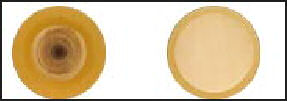
The earliest forms of cultivated pearls were pearl Buddhas first produced in the 12th century by the Chinese. These tiny figurines were created by cementing a small Buddha carving of ivory, wood, stone or metal onto the shell of a freshwater mussel shell until they were coated with nacre. A similar technique is used today to create half pearls in freshwater oysters.
After hundred of years of trials and errors three Japanese working alone invented a technique for producing cultivated oysters at the beginning of the 20th century. One of the inventors was a teenage carpenter named Tatsuhei Mise and another was government marine biologist at Tokyo University named Tokichi Nishikawa. The other was Kokichi Mikimoto.
Kinds of Cultured Pearls
There are three main varieties of pearls: 1) white akoya pearls , mostly from Japan; 2) black, gold, white South Sea pearls, mostly from Tahiti, Australia and Indonesia; and 2) Chinese freshwater pearls.
Akoya pearls are 5 to 9 millimeters in diameter and
South Sea pearls have a diameter of 10 to 15 millimeters. Their thick nacre gives them their great size and a deep luster and makes them less likely to discolor of degenerate. . They are three to 20 times more expensive than Akoya pearls.
Freshwater Pearls
China leads the world in the production of freshwater pearls. It supplies about 99.9 percent of the freshwater pearls for the world market, producing 1,500 tons a year. The worldwide saltwater production is only 60 tons. China produced only 80 tons of freshwater pearls in the mid-1980s.
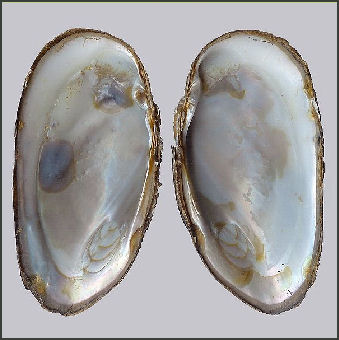
freshwater pearl shell Freshwater pearls come from mussels. In nature they are small, weirdly-shaped, and oddly-colored. They tend to grow in clusters and often end up looking like Rice Krispies. Even the cultured ones used in jewelry are not usually round or white.
The earliest forms of cultivated pearls were pearl Buddhas first produced around A.D. 800 by the Chinese. These tiny figurines were created by attaching a small Buddha carving of ivory, wood, stone or metal onto the inside of a freshwater mussel shell. After a couple of years they were coated with nacre to produce a pearl Buddha. [Source: Fred Ward, National Geographic, August 1985]
Freshwater Pearl Market
In recent years producers have figured out how to make freshwater pearls bigger, rounder and more like saltwater pearls. Retailers are now offering jewelry made with freshwater pearls at a fraction of the price of similar jewelry made with saltwater pearls. Tiffany sells oval freshwater pearl bracelets for $250 and necklaces for $375.
In the old days, there was virtually no market within China for pearls, except for medicines and cosmetics. Pearls raised by farmers were often traded to Hong Kong smugglers for televisions, watches and radios.
Freshwater pearls have been used in jewelry worn by Diamond Li Russell at the turn of the 20th century and in multi strand toussades designed by Paloma Picasso. But for the most part they were not taken seriously. A market for them was created in early 1990s when Japanese pearl production declined as a result of an oyster diseases and Chinese scientists figured out how to make quality freshwater pearls.
A 9.4-millimeter-in-diameter freshwater pearl from sells for $125 while a 9.2-millimeter-in-diameter Akoya saltwater pearl from Japan sells for $350. To the untrained eye they look almost the same. Small off-white, oval-shaped freshwater pearls are very cheap, often cheaper than imitations.
Freshwater Pearl Production
Freshwater pearls are farmed in rivers, streams and rice paddies. The Chinese were able to improve the quality of freshwater pearls by changing the mussel species from Cristaria plicata to Hyriopris, the Chinese triangle mussel, and injecting material into the mantle tissue when the mussels are 2½ years old rather than one year as was the case before.

grafting shed Around Shanghai, pearl-bearing oysters are raised in fish ponds and irrigation canals. The pearls are cultured with a piece of mantle from another mussel. As the Chinese have improved cultivation methods, the quality has not only improved but production costs have dropped. Pearls processed in China for export are often drilled with twine and primitive bows by teenage girls working for 16 U.S. cents an hour.
The Chinese government encourages the harvesting of pearls as a means of raising hard currency and most of the shells raised by farmers have been implanted by the government and given to farmers who raise them for two years and then sell them back to the government.
Japanese cultivators put only one or two nuclei intro each oyster which results in one or two pearls. Chinese producers put in a many as 10.
There are fears that the Chinese pursuit of short-term profits make endanger the pearl industry as a whole. One Japanese exporter said, “The Chinese vendors sell high-quality pearls. But at very cheap prices, which forces down the prices elsewhere. I wish they would adopt a more sustainable approach.:
Image Sources: Mikimoto Pearl Museum, Wikipedia
Text Sources: New York Times, Washington Post, Los Angeles Times, Daily Yomiuri, Times of London, Japan National Tourist Organization (JNTO), National Geographic, The New Yorker, Time, Newsweek, Reuters, AP, Lonely Planet Guides, Compton’s Encyclopedia and various books and other publications.
Last updated March 2023
